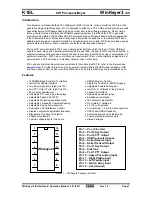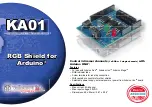
CHAPTER 11 SERIAL INTERFACE CSI10
Preliminary User’s Manual U19014EJ1V0UD
262
The relationship between the register settings and pins is shown below.
Table 11-2. Relationship Between Register Settings and Pins
Pin Function
CSIE10 TRMD10 PM11
P11
PM12
P12
PM10
P10
CSI10
Operation
SI10/P11 SO10/P12 SCK10/
P10
0 ×
×
Note 1
×
Note 1
×
Note 1
×
Note 1
×
Note 1
×
Note 1
Stop
P11 P12
P10
Note 2
1 0 1
×
×
Note 1
×
Note 1
1
×
Slave
reception
Note 3
SI10 P12
SCK10
(input)
Note 3
1 1
×
Note 1
×
Note 1
0 0 1
×
Slave
transmission
Note 3
P11 SO10
SCK10
(input)
Note 3
1 1 1
×
0 0 1
×
Slave
transmission/
reception
Note 3
SI10 SO10
SCK10
(input)
Note 3
1 0 1
×
×
Note 1
×
Note 1
0 1
Master
reception
SI10
P12 SCK10
(output)
1 1
×
Note 1
×
Note 1
0 0 0 1
Master
transmission
P11 SO10
SCK10
(output)
1 1 1
×
0 0 0 1
Master
transmission/
reception
SI10 SO10
SCK10
(output)
Notes 1.
Can be set as port function.
2.
To use P10/SCK10 as port pins, clear CKP10 to 0.
3.
To use the slave mode, set CKS102, CKS101, and CKS100 to 1, 1, 1.
Remark
×
:
don’t care
CSIE10:
Bit 7 of serial operation mode register 10 (CSIM10)
TRMD10:
Bit 6 of CSIM10
CKP10:
Bit 4 of serial clock selection register 10 (CSIC10)
CKS102, CKS101, CKS100: Bits 2 to 0 of CSIC10
PM1
×
:
Port mode register
P1
×
:
Port output latch
electronic components distributor
















































